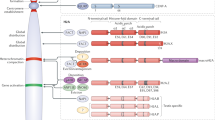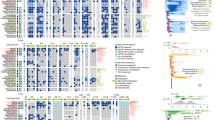Abstract
THE genome of eukaryotes is organised in nucleoprotein fibres formed by the interaction of the DNA with small basic proteins, the histones, and by specific interactions between certain histones1. To gain more insight into the molecular organisation of chromosomes it is necessary to determine in detail the complexity and variability of the histones. The chromosomes of eukaryotes contain five major types of histones. One of these, the very lysine-rich H1, consists of a small number of poly-peptides which differ slightly in primary structure and which are present in different relative amounts in different tissues2. The other four histones, which are involved in histone–histone interactions, were considered homogeneous and invariable until it became possible to resolve H2a, H2b and H3 into variants which exhibit tissue-specific variation by polyacrylamide gel electrophoresis in presence of non-ionic detergents3 (Fig. 1). We report here on the primary structure of the variants of mammalian histones 2a, 2b and 3.
This is a preview of subscription content, access via your institution
Access options
Subscribe to this journal
Receive 51 print issues and online access
$199.00 per year
only $3.90 per issue
Buy this article
- Purchase on Springer Link
- Instant access to full article PDF
Prices may be subject to local taxes which are calculated during checkout
Similar content being viewed by others
References
Elgin, S. C. R. & Weintraub, H. A. Rev. Biochem. 44, 725–774 (1975).
Kinkade, J. M., Jr & Cole, R. D. J. biol. Chem. 241, 5790–5797 and 5798–5805 (1966); 244, 3375–3386 (1969).
Zweidler, A. in Methods in Chromosomal Protein Research (eds Stein, G. & Stein, S.) (Academic, New York, in the press).
Johns, E. W. Biochem. J. 92, 55–59 (1964); ibid. 105, 611–614 (1967).
Franklin, S. G. & Zweidler, A. J. Cell Biol. 67, 122a (1975).
Felix, A. M. & Jimenez, M. H. J. Chromatog. 89, 361–364 (1974).
Mendez, E. & Lai, C. Y. Analyt. Biochem. 65, 281–292 (1975).
Yeoman, C. E. et al. J. biol. Chem. 247, 6018–6023 (1972).
Iwai, K., Hayashi, H. & Ishikawa, K. J. Biochem., 72, 357–367 (1972).
DeLange, R. J., Hooper, J. R. & Smith, E. L. J. biol. Chem. 248, 3261–3274 (1973).
Laine, B., Sautiere, P. & Biserte, G. Biochemistry 15, 1640–1645 (1976).
Ishikawa, K., Hayashi, H. & Iwai, K. J. Biochem. 72, 299–326 (1972).
Patthy, L. & Smith, E. L. J. biol. Chem. 250, 1919–1920 (1975).
Brandt, W. F., Strickland, W. N. & Von Holt, C. FEBS Lett. 40, 349–352 (1974).
Hooper, J. A., Smith, E. L., Sommer, K. R. & Chalkley, R. J. biol. Chem. 248, 3275–3279 (1973).
Brandt, W. F. thesis, Univ. Cape Town (1972).
Patthy, L., Smith, E. L. & Johnson, L. J. biol. Chem. 248, 6834–6840 (1973).
Dayhoff, M. D. Atlas of Protein Sequence and Structure, 4 (National Biomedical Research Foundation, Maryland, 1969).
Scheraga, H. A. in Current Topics in Biochemistry (eds Anfinsen, C. B. & Schechter, A. N.) 1–42 (Academic, New York, 1974).
Lewis, P. N. & Bradbury, E. M. Biochem. biophys. Acta 336, 153–164 (1974).
Hamand, K. & Iwai, K. J. Biochem. 79, 125–129 (1976).
Zweidler, A. Arch. Genetik (in the press).
Zweidler, A. in Organisation and Expression of Chromosomes (eds Allfrey, V. G., Bautz, E. K. F., McCarthy, B. J., Schimke, R. T. & Tissieres, A.) 187–196 (Berlin: Dahlem Konferenzen, 1976).
Borun, T. W., Gabrielli, F., Ajiro, K., Zweidler, A. & Baglioni, C. Cell 4, 59–67 (1975).
Borun, T. W., Ajiro, K., Zweidler, A., Dolby, T. W. & Stephens, R. E. J. biol. Chem. 252, 173–180 (1976).
Cohen, L. H., Newrock, K. M. & Zweidler, A. Science 190, 994–997 (1975).
Goodwin, G. H., Sanders, C. & Johns, E. W. Eur. J. Biochem. 38, 14–19 (1973).
Bradbury, E. M., Hjelm, R. P. & Baldwin, J. P., in Organization and Expression of Chromosomes (eds Allfrey, V. G., Bautz, E. K. F., McCarthy, B. J., Schimke, R. T. & Tissieres, A.) 223–238 (Dahlem Konferenzen, Berlin, 1976).
Author information
Authors and Affiliations
Rights and permissions
About this article
Cite this article
FRANKLIN, S., ZWEIDLER, A. Non-allelic variants of histones 2a, 2b and 3 in mammals. Nature 266, 273–275 (1977). https://doi.org/10.1038/266273a0
Received:
Accepted:
Published:
Issue Date:
DOI: https://doi.org/10.1038/266273a0
This article is cited by
-
A standardized nomenclature for mammalian histone genes
Epigenetics & Chromatin (2022)
-
Epigenetics and genome stability
Mammalian Genome (2020)
-
Histone H3.5 forms an unstable nucleosome and accumulates around transcription start sites in human testis
Epigenetics & Chromatin (2016)
-
Histone H3 mutations—a special role for H3.3 in tumorigenesis?
Chromosoma (2015)
-
Structural basis of a nucleosome containing histone H2A.B/H2A.Bbd that transiently associates with reorganized chromatin
Scientific Reports (2013)
Comments
By submitting a comment you agree to abide by our Terms and Community Guidelines. If you find something abusive or that does not comply with our terms or guidelines please flag it as inappropriate.



